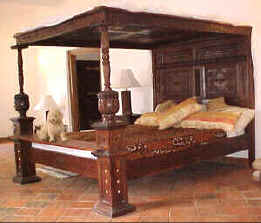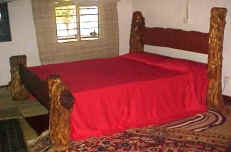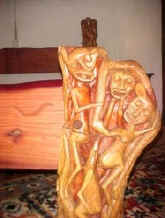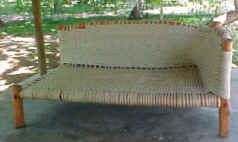AUSSIE MIKE'S WORK, TIPS &
TECHNIQUES
As we've noticed before, Mike Calnan's woodworking is more art
than anything
else. It will make you a believer of spirits in wood. These are totally unique
woodworking projects guided by what the wood tells the artist.
Page
1 Aussie Mike's African Home
Page
2 - The Funzi Furniture Factory
Page
3 - Mikes Work and Tips and Techniques
Page
4 - Mike and Sabine's Personal Paradise
Page
5 - Sabine's Work and Mike's New Project
|
In talking about the projects Aussie Mike has enjoyed the most, the artist in him comes out. During his description of his favorite type of project, the story of the bed to the left was explained. "I truly love finding
pieces that no one else wants, driftwood, roots, old dhows (woodenboats),
and creating a functional piece of art from them. |
 |
|
|
Sabine has taken over most of the manufacture of the furniture at the Funzi Factory. Just to the left is her Shetani Bed. . A unique double bed with carved shetani legs. The legs are from the neem tree and the headboard is mahogany from the Congo Both Mike and Sabine have an affinity for the feel of the wood and allow it to guide them in the design of functional furniture from unusual pieces of fallen timber and tree roots. There are no patterns and no time limits. Mike describes the process this way: "It is not so much as
how much in a week as how much in a year. Most of the work I do can
take a year. Much of that time can be trying to see what the piece
holds. What is hidden beneath the dirt and old bark. The shape and
form within. What can it hold and how do I make it functional? |
|
The chaise lounge and the gecko bed are two other projects developed around the available wood and materials available in this area. Note the curve of the leg on the gecko bed, determined by the shape of the wood. Mike expresses his philosophy and technique as a tip for novice woodworkers below: "I do not make things to
order. I make it. You like it, you buy it. I do not think this good
advice to a young woodworker in your country, but the ones it does
apply to will be more successful in their work. |
|
CONTACT US AT mailto:sawdustone@earthlink.net
Copyright © 2001-2002 Sawdust Studios. All Rights Reserved




